Supply Chain Management Report
VerifiedAdded on 2020/03/04
|13
|3165
|105
Report
AI Summary
This report examines the supply chain management practices of Thomas Cook, a leading tourism organization. It discusses the integration of technology and local partnerships to enhance customer experiences and sustainability. The report highlights the role of the Travellife system in monitoring and improving supply chain activities, ensuring quality services, and maintaining effective communication across the supply chain. Through strategic management, Thomas Cook aims to provide world-class tourism experiences while promoting sustainable practices.
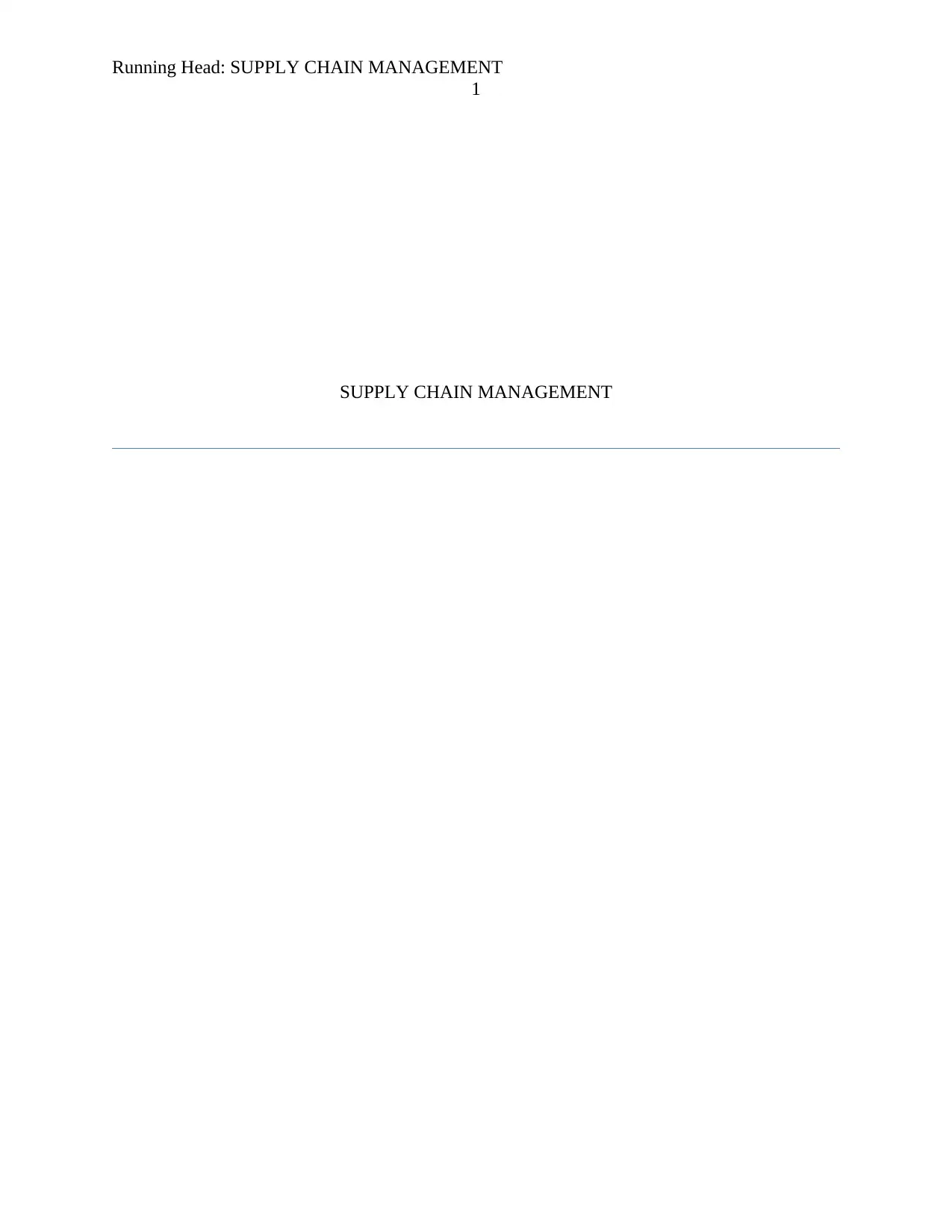
Running Head: SUPPLY CHAIN MANAGEMENT
1
SUPPLY CHAIN MANAGEMENT
1
SUPPLY CHAIN MANAGEMENT
Paraphrase This Document
Need a fresh take? Get an instant paraphrase of this document with our AI Paraphraser
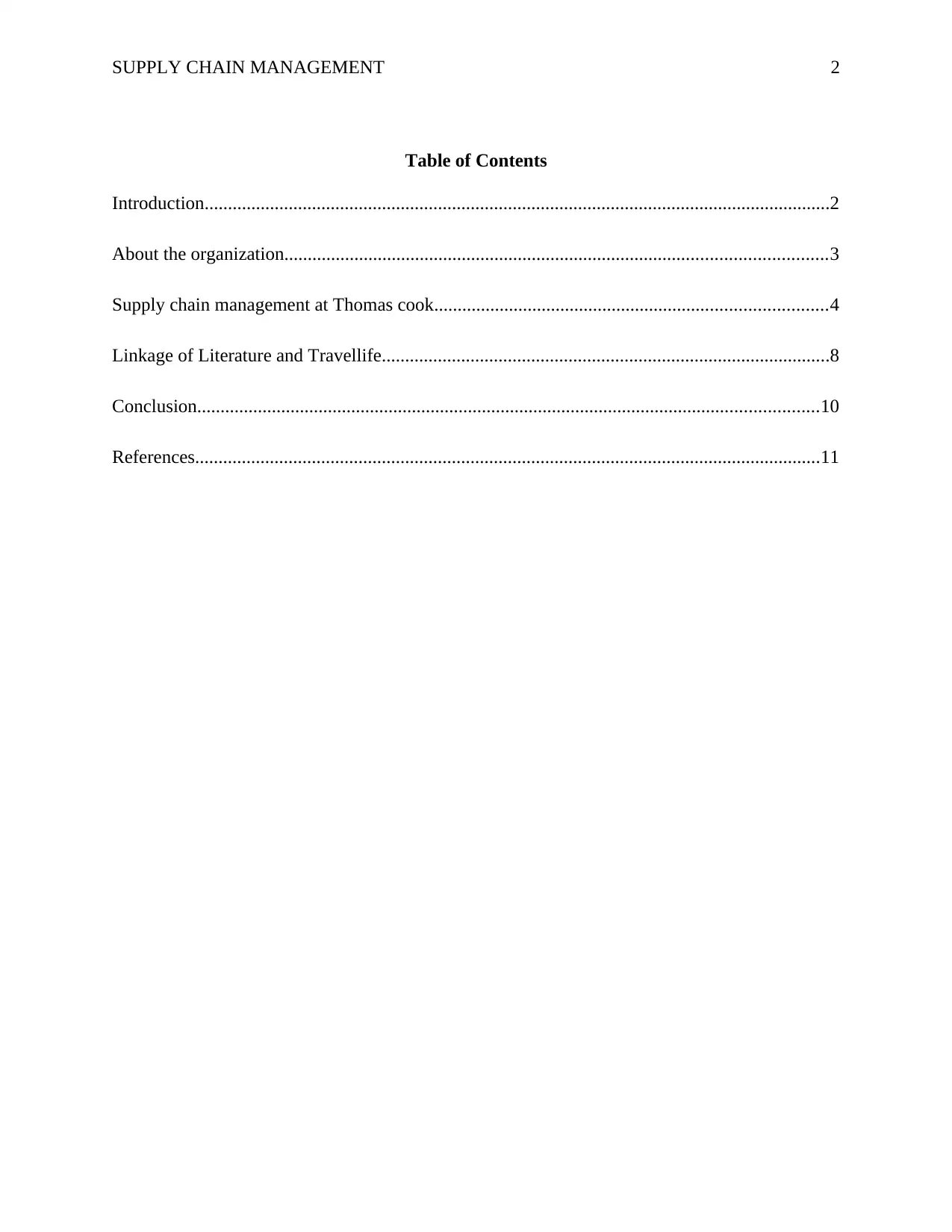
SUPPLY CHAIN MANAGEMENT 2
Table of Contents
Introduction......................................................................................................................................2
About the organization....................................................................................................................3
Supply chain management at Thomas cook....................................................................................4
Linkage of Literature and Travellife................................................................................................8
Conclusion.....................................................................................................................................10
References......................................................................................................................................11
Table of Contents
Introduction......................................................................................................................................2
About the organization....................................................................................................................3
Supply chain management at Thomas cook....................................................................................4
Linkage of Literature and Travellife................................................................................................8
Conclusion.....................................................................................................................................10
References......................................................................................................................................11
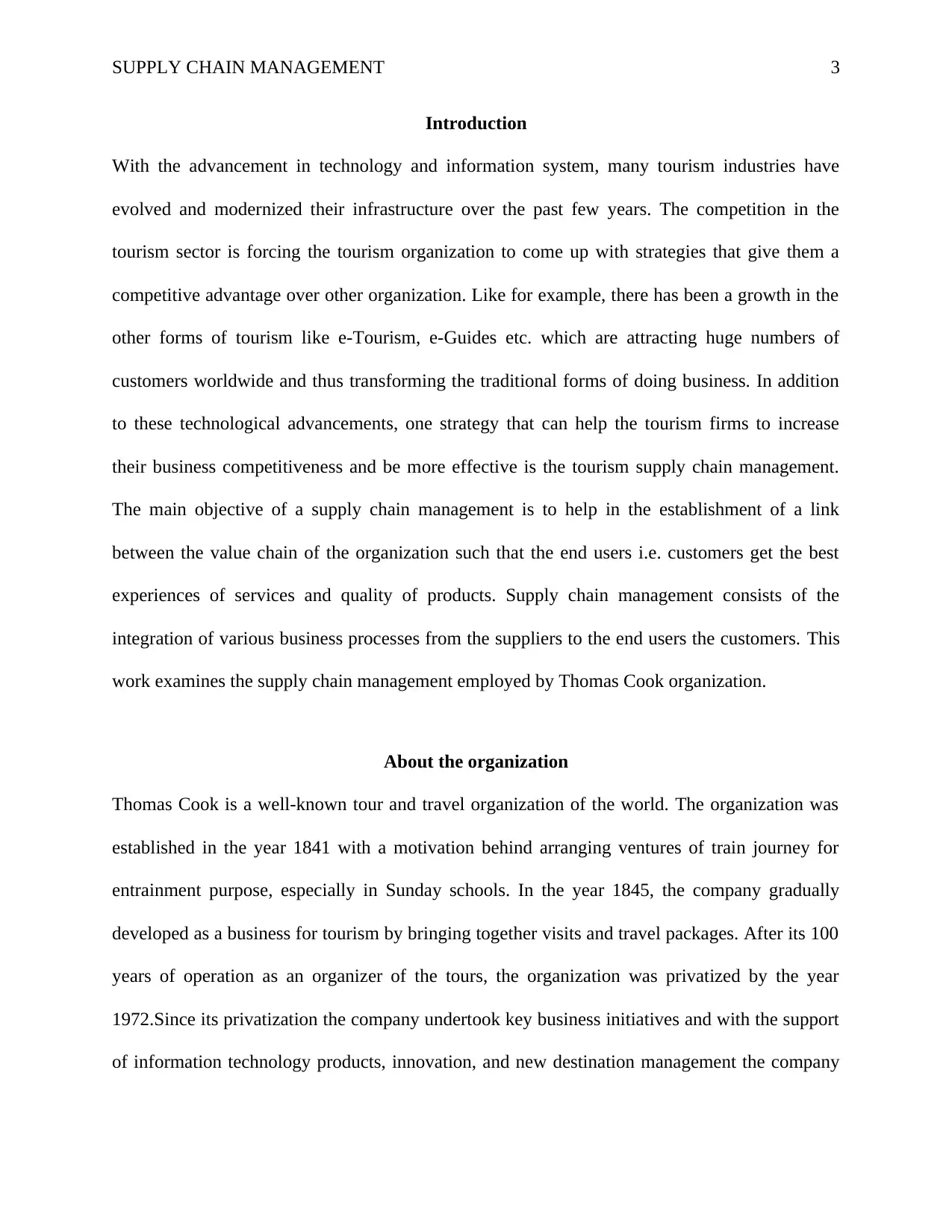
SUPPLY CHAIN MANAGEMENT 3
Introduction
With the advancement in technology and information system, many tourism industries have
evolved and modernized their infrastructure over the past few years. The competition in the
tourism sector is forcing the tourism organization to come up with strategies that give them a
competitive advantage over other organization. Like for example, there has been a growth in the
other forms of tourism like e-Tourism, e-Guides etc. which are attracting huge numbers of
customers worldwide and thus transforming the traditional forms of doing business. In addition
to these technological advancements, one strategy that can help the tourism firms to increase
their business competitiveness and be more effective is the tourism supply chain management.
The main objective of a supply chain management is to help in the establishment of a link
between the value chain of the organization such that the end users i.e. customers get the best
experiences of services and quality of products. Supply chain management consists of the
integration of various business processes from the suppliers to the end users the customers. This
work examines the supply chain management employed by Thomas Cook organization.
About the organization
Thomas Cook is a well-known tour and travel organization of the world. The organization was
established in the year 1841 with a motivation behind arranging ventures of train journey for
entrainment purpose, especially in Sunday schools. In the year 1845, the company gradually
developed as a business for tourism by bringing together visits and travel packages. After its 100
years of operation as an organizer of the tours, the organization was privatized by the year
1972.Since its privatization the company undertook key business initiatives and with the support
of information technology products, innovation, and new destination management the company
Introduction
With the advancement in technology and information system, many tourism industries have
evolved and modernized their infrastructure over the past few years. The competition in the
tourism sector is forcing the tourism organization to come up with strategies that give them a
competitive advantage over other organization. Like for example, there has been a growth in the
other forms of tourism like e-Tourism, e-Guides etc. which are attracting huge numbers of
customers worldwide and thus transforming the traditional forms of doing business. In addition
to these technological advancements, one strategy that can help the tourism firms to increase
their business competitiveness and be more effective is the tourism supply chain management.
The main objective of a supply chain management is to help in the establishment of a link
between the value chain of the organization such that the end users i.e. customers get the best
experiences of services and quality of products. Supply chain management consists of the
integration of various business processes from the suppliers to the end users the customers. This
work examines the supply chain management employed by Thomas Cook organization.
About the organization
Thomas Cook is a well-known tour and travel organization of the world. The organization was
established in the year 1841 with a motivation behind arranging ventures of train journey for
entrainment purpose, especially in Sunday schools. In the year 1845, the company gradually
developed as a business for tourism by bringing together visits and travel packages. After its 100
years of operation as an organizer of the tours, the organization was privatized by the year
1972.Since its privatization the company undertook key business initiatives and with the support
of information technology products, innovation, and new destination management the company
⊘ This is a preview!⊘
Do you want full access?
Subscribe today to unlock all pages.

Trusted by 1+ million students worldwide
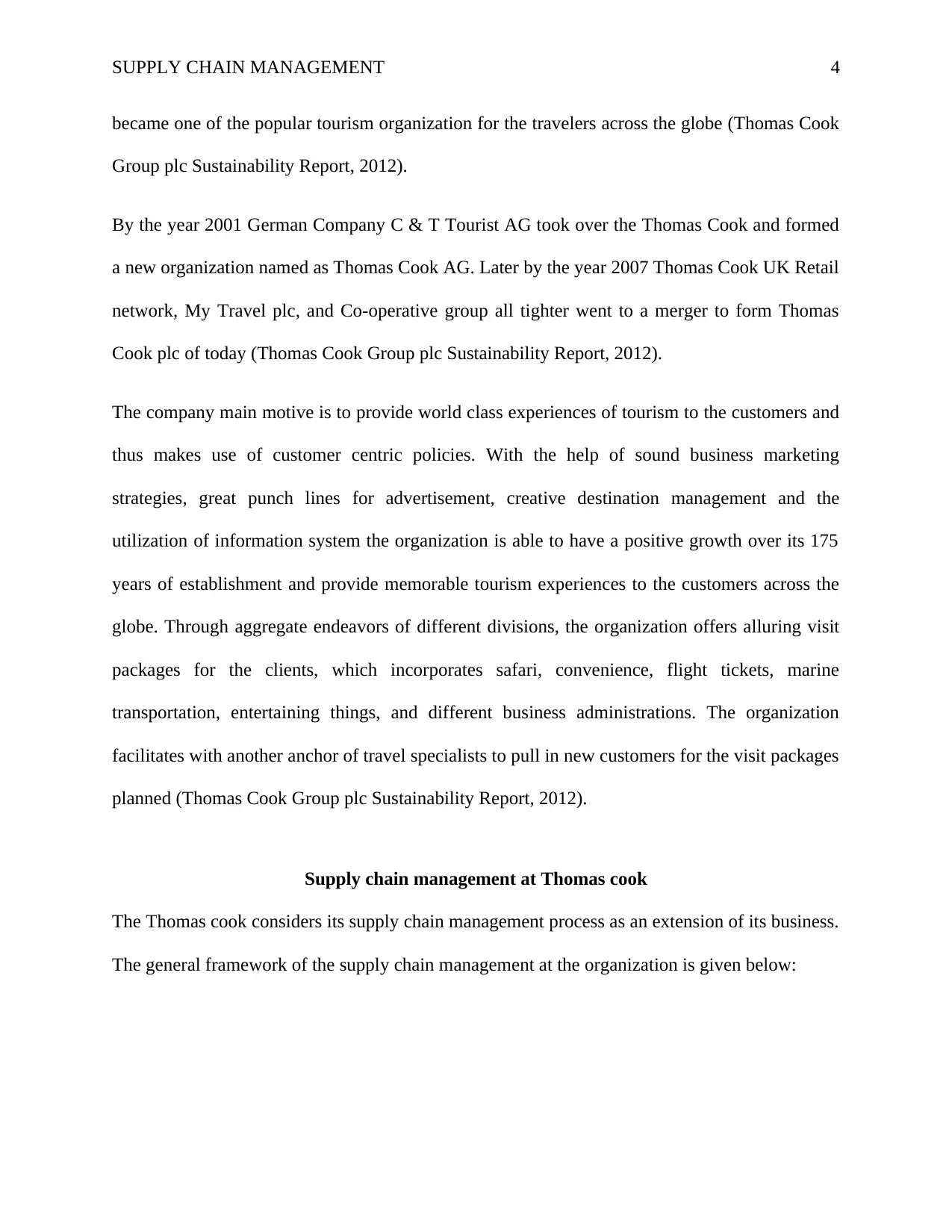
SUPPLY CHAIN MANAGEMENT 4
became one of the popular tourism organization for the travelers across the globe (Thomas Cook
Group plc Sustainability Report, 2012).
By the year 2001 German Company C & T Tourist AG took over the Thomas Cook and formed
a new organization named as Thomas Cook AG. Later by the year 2007 Thomas Cook UK Retail
network, My Travel plc, and Co-operative group all tighter went to a merger to form Thomas
Cook plc of today (Thomas Cook Group plc Sustainability Report, 2012).
The company main motive is to provide world class experiences of tourism to the customers and
thus makes use of customer centric policies. With the help of sound business marketing
strategies, great punch lines for advertisement, creative destination management and the
utilization of information system the organization is able to have a positive growth over its 175
years of establishment and provide memorable tourism experiences to the customers across the
globe. Through aggregate endeavors of different divisions, the organization offers alluring visit
packages for the clients, which incorporates safari, convenience, flight tickets, marine
transportation, entertaining things, and different business administrations. The organization
facilitates with another anchor of travel specialists to pull in new customers for the visit packages
planned (Thomas Cook Group plc Sustainability Report, 2012).
Supply chain management at Thomas cook
The Thomas cook considers its supply chain management process as an extension of its business.
The general framework of the supply chain management at the organization is given below:
became one of the popular tourism organization for the travelers across the globe (Thomas Cook
Group plc Sustainability Report, 2012).
By the year 2001 German Company C & T Tourist AG took over the Thomas Cook and formed
a new organization named as Thomas Cook AG. Later by the year 2007 Thomas Cook UK Retail
network, My Travel plc, and Co-operative group all tighter went to a merger to form Thomas
Cook plc of today (Thomas Cook Group plc Sustainability Report, 2012).
The company main motive is to provide world class experiences of tourism to the customers and
thus makes use of customer centric policies. With the help of sound business marketing
strategies, great punch lines for advertisement, creative destination management and the
utilization of information system the organization is able to have a positive growth over its 175
years of establishment and provide memorable tourism experiences to the customers across the
globe. Through aggregate endeavors of different divisions, the organization offers alluring visit
packages for the clients, which incorporates safari, convenience, flight tickets, marine
transportation, entertaining things, and different business administrations. The organization
facilitates with another anchor of travel specialists to pull in new customers for the visit packages
planned (Thomas Cook Group plc Sustainability Report, 2012).
Supply chain management at Thomas cook
The Thomas cook considers its supply chain management process as an extension of its business.
The general framework of the supply chain management at the organization is given below:
Paraphrase This Document
Need a fresh take? Get an instant paraphrase of this document with our AI Paraphraser
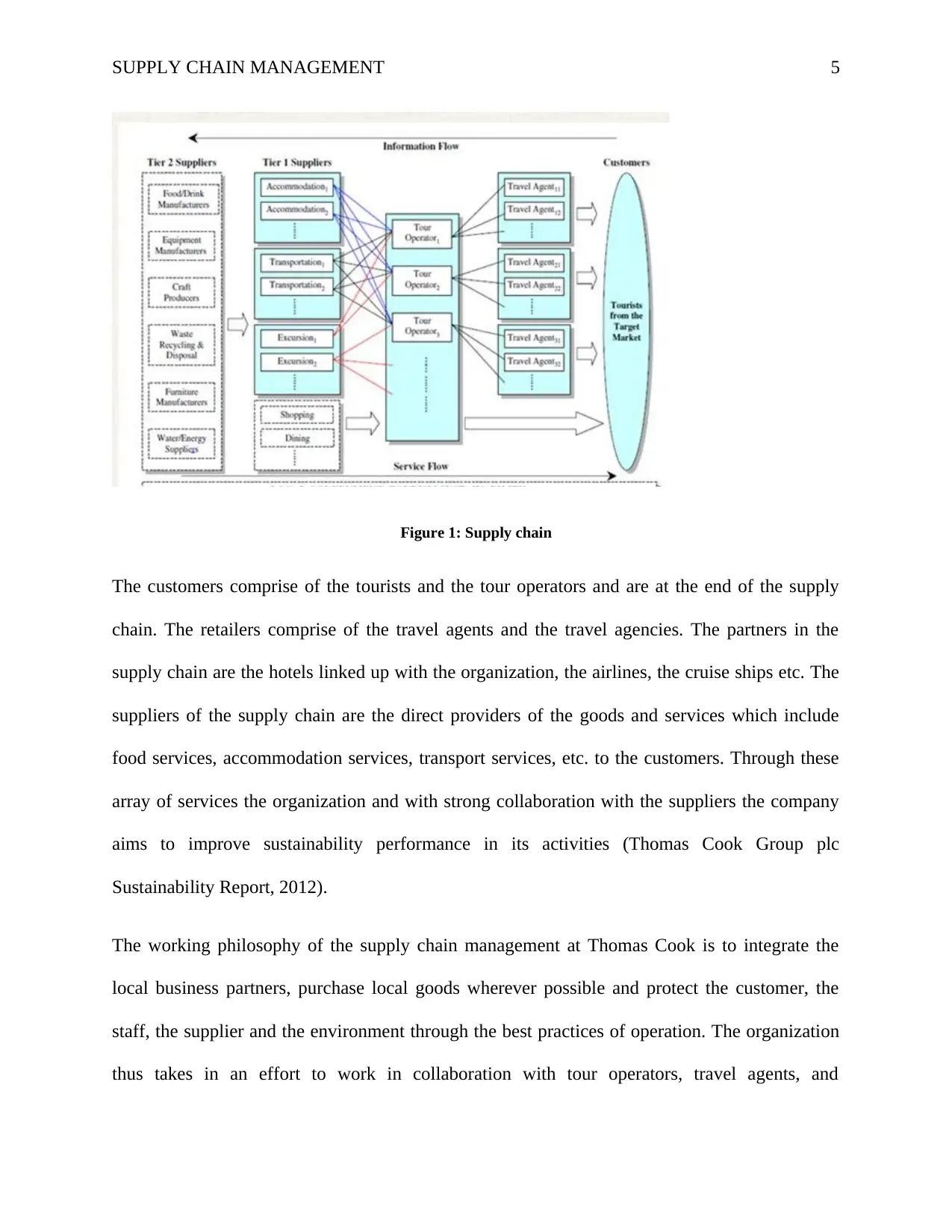
SUPPLY CHAIN MANAGEMENT 5
Figure 1: Supply chain
The customers comprise of the tourists and the tour operators and are at the end of the supply
chain. The retailers comprise of the travel agents and the travel agencies. The partners in the
supply chain are the hotels linked up with the organization, the airlines, the cruise ships etc. The
suppliers of the supply chain are the direct providers of the goods and services which include
food services, accommodation services, transport services, etc. to the customers. Through these
array of services the organization and with strong collaboration with the suppliers the company
aims to improve sustainability performance in its activities (Thomas Cook Group plc
Sustainability Report, 2012).
The working philosophy of the supply chain management at Thomas Cook is to integrate the
local business partners, purchase local goods wherever possible and protect the customer, the
staff, the supplier and the environment through the best practices of operation. The organization
thus takes in an effort to work in collaboration with tour operators, travel agents, and
Figure 1: Supply chain
The customers comprise of the tourists and the tour operators and are at the end of the supply
chain. The retailers comprise of the travel agents and the travel agencies. The partners in the
supply chain are the hotels linked up with the organization, the airlines, the cruise ships etc. The
suppliers of the supply chain are the direct providers of the goods and services which include
food services, accommodation services, transport services, etc. to the customers. Through these
array of services the organization and with strong collaboration with the suppliers the company
aims to improve sustainability performance in its activities (Thomas Cook Group plc
Sustainability Report, 2012).
The working philosophy of the supply chain management at Thomas Cook is to integrate the
local business partners, purchase local goods wherever possible and protect the customer, the
staff, the supplier and the environment through the best practices of operation. The organization
thus takes in an effort to work in collaboration with tour operators, travel agents, and
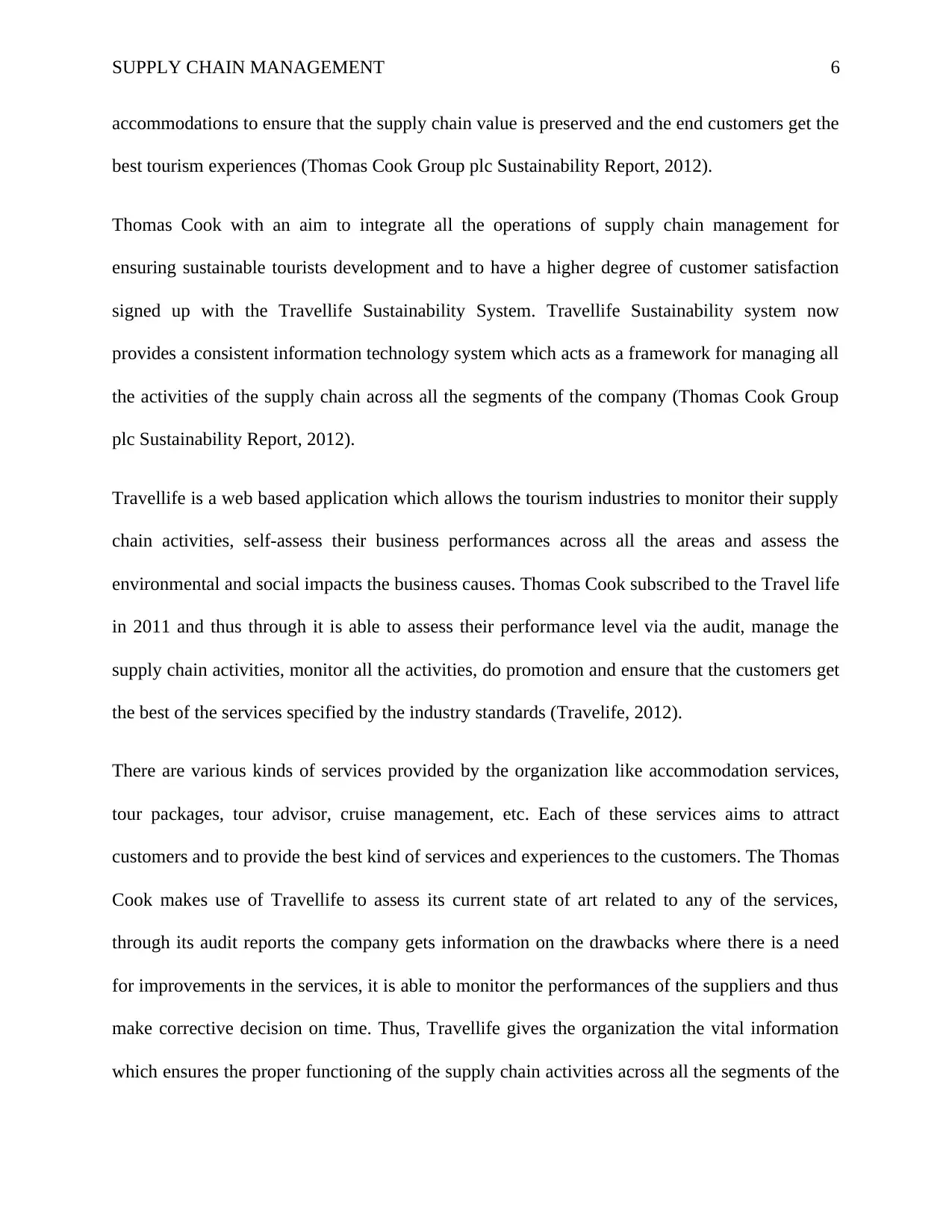
SUPPLY CHAIN MANAGEMENT 6
accommodations to ensure that the supply chain value is preserved and the end customers get the
best tourism experiences (Thomas Cook Group plc Sustainability Report, 2012).
Thomas Cook with an aim to integrate all the operations of supply chain management for
ensuring sustainable tourists development and to have a higher degree of customer satisfaction
signed up with the Travellife Sustainability System. Travellife Sustainability system now
provides a consistent information technology system which acts as a framework for managing all
the activities of the supply chain across all the segments of the company (Thomas Cook Group
plc Sustainability Report, 2012).
Travellife is a web based application which allows the tourism industries to monitor their supply
chain activities, self-assess their business performances across all the areas and assess the
environmental and social impacts the business causes. Thomas Cook subscribed to the Travel life
in 2011 and thus through it is able to assess their performance level via the audit, manage the
supply chain activities, monitor all the activities, do promotion and ensure that the customers get
the best of the services specified by the industry standards (Travelife, 2012).
There are various kinds of services provided by the organization like accommodation services,
tour packages, tour advisor, cruise management, etc. Each of these services aims to attract
customers and to provide the best kind of services and experiences to the customers. The Thomas
Cook makes use of Travellife to assess its current state of art related to any of the services,
through its audit reports the company gets information on the drawbacks where there is a need
for improvements in the services, it is able to monitor the performances of the suppliers and thus
make corrective decision on time. Thus, Travellife gives the organization the vital information
which ensures the proper functioning of the supply chain activities across all the segments of the
accommodations to ensure that the supply chain value is preserved and the end customers get the
best tourism experiences (Thomas Cook Group plc Sustainability Report, 2012).
Thomas Cook with an aim to integrate all the operations of supply chain management for
ensuring sustainable tourists development and to have a higher degree of customer satisfaction
signed up with the Travellife Sustainability System. Travellife Sustainability system now
provides a consistent information technology system which acts as a framework for managing all
the activities of the supply chain across all the segments of the company (Thomas Cook Group
plc Sustainability Report, 2012).
Travellife is a web based application which allows the tourism industries to monitor their supply
chain activities, self-assess their business performances across all the areas and assess the
environmental and social impacts the business causes. Thomas Cook subscribed to the Travel life
in 2011 and thus through it is able to assess their performance level via the audit, manage the
supply chain activities, monitor all the activities, do promotion and ensure that the customers get
the best of the services specified by the industry standards (Travelife, 2012).
There are various kinds of services provided by the organization like accommodation services,
tour packages, tour advisor, cruise management, etc. Each of these services aims to attract
customers and to provide the best kind of services and experiences to the customers. The Thomas
Cook makes use of Travellife to assess its current state of art related to any of the services,
through its audit reports the company gets information on the drawbacks where there is a need
for improvements in the services, it is able to monitor the performances of the suppliers and thus
make corrective decision on time. Thus, Travellife gives the organization the vital information
which ensures the proper functioning of the supply chain activities across all the segments of the
⊘ This is a preview!⊘
Do you want full access?
Subscribe today to unlock all pages.

Trusted by 1+ million students worldwide
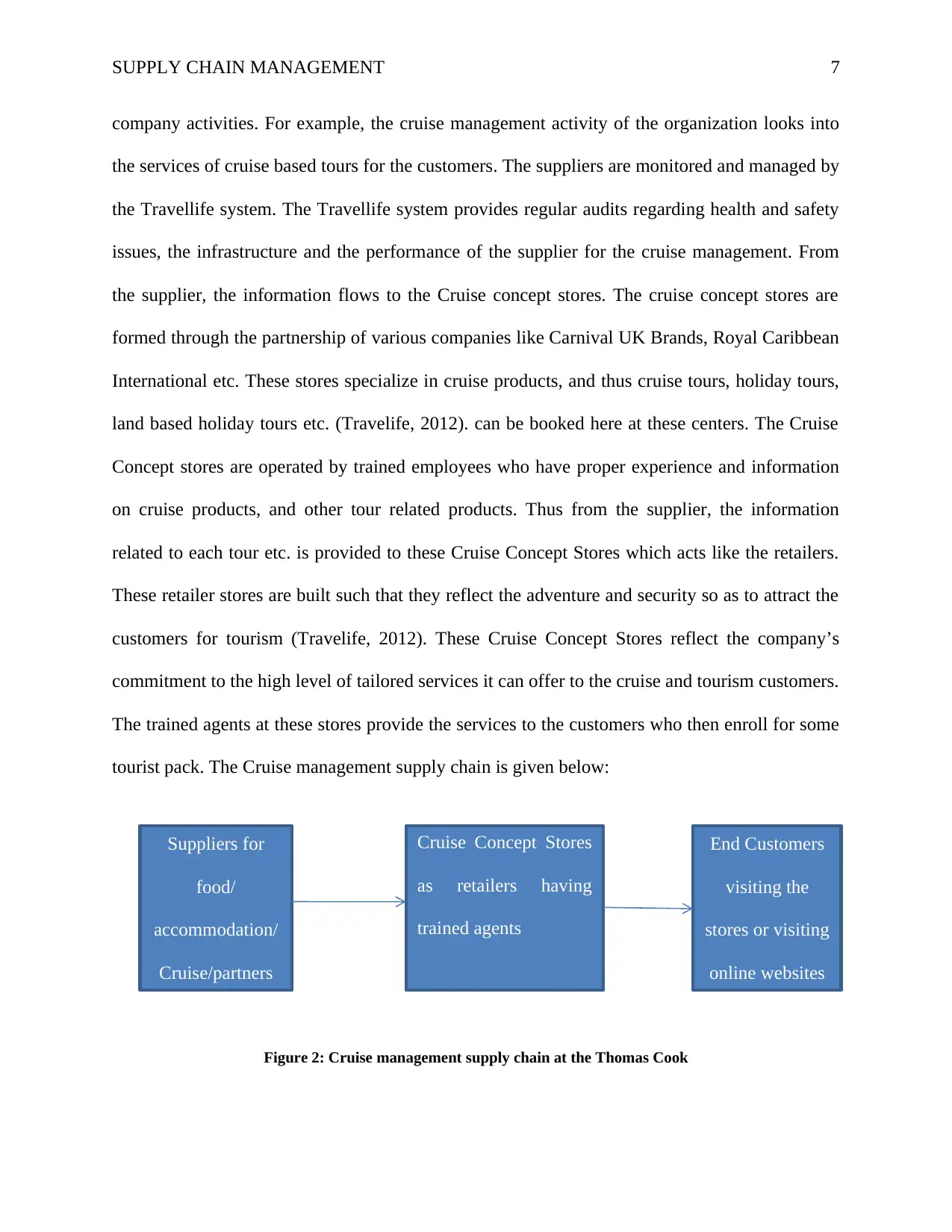
SUPPLY CHAIN MANAGEMENT 7
company activities. For example, the cruise management activity of the organization looks into
the services of cruise based tours for the customers. The suppliers are monitored and managed by
the Travellife system. The Travellife system provides regular audits regarding health and safety
issues, the infrastructure and the performance of the supplier for the cruise management. From
the supplier, the information flows to the Cruise concept stores. The cruise concept stores are
formed through the partnership of various companies like Carnival UK Brands, Royal Caribbean
International etc. These stores specialize in cruise products, and thus cruise tours, holiday tours,
land based holiday tours etc. (Travelife, 2012). can be booked here at these centers. The Cruise
Concept stores are operated by trained employees who have proper experience and information
on cruise products, and other tour related products. Thus from the supplier, the information
related to each tour etc. is provided to these Cruise Concept Stores which acts like the retailers.
These retailer stores are built such that they reflect the adventure and security so as to attract the
customers for tourism (Travelife, 2012). These Cruise Concept Stores reflect the company’s
commitment to the high level of tailored services it can offer to the cruise and tourism customers.
The trained agents at these stores provide the services to the customers who then enroll for some
tourist pack. The Cruise management supply chain is given below:
Figure 2: Cruise management supply chain at the Thomas Cook
Suppliers for
food/
accommodation/
Cruise/partners
Cruise Concept Stores
as retailers having
trained agents
End Customers
visiting the
stores or visiting
online websites
company activities. For example, the cruise management activity of the organization looks into
the services of cruise based tours for the customers. The suppliers are monitored and managed by
the Travellife system. The Travellife system provides regular audits regarding health and safety
issues, the infrastructure and the performance of the supplier for the cruise management. From
the supplier, the information flows to the Cruise concept stores. The cruise concept stores are
formed through the partnership of various companies like Carnival UK Brands, Royal Caribbean
International etc. These stores specialize in cruise products, and thus cruise tours, holiday tours,
land based holiday tours etc. (Travelife, 2012). can be booked here at these centers. The Cruise
Concept stores are operated by trained employees who have proper experience and information
on cruise products, and other tour related products. Thus from the supplier, the information
related to each tour etc. is provided to these Cruise Concept Stores which acts like the retailers.
These retailer stores are built such that they reflect the adventure and security so as to attract the
customers for tourism (Travelife, 2012). These Cruise Concept Stores reflect the company’s
commitment to the high level of tailored services it can offer to the cruise and tourism customers.
The trained agents at these stores provide the services to the customers who then enroll for some
tourist pack. The Cruise management supply chain is given below:
Figure 2: Cruise management supply chain at the Thomas Cook
Suppliers for
food/
accommodation/
Cruise/partners
Cruise Concept Stores
as retailers having
trained agents
End Customers
visiting the
stores or visiting
online websites
Paraphrase This Document
Need a fresh take? Get an instant paraphrase of this document with our AI Paraphraser
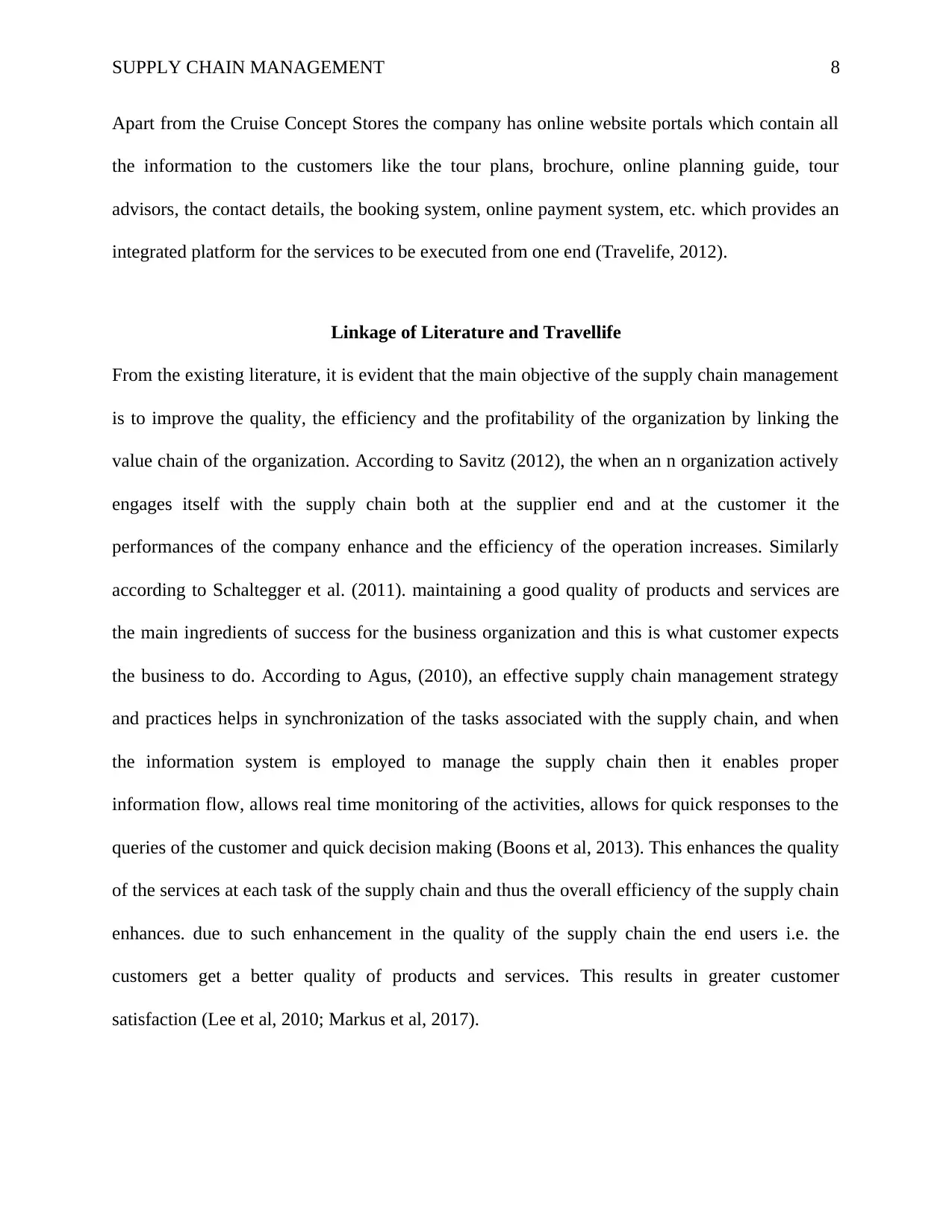
SUPPLY CHAIN MANAGEMENT 8
Apart from the Cruise Concept Stores the company has online website portals which contain all
the information to the customers like the tour plans, brochure, online planning guide, tour
advisors, the contact details, the booking system, online payment system, etc. which provides an
integrated platform for the services to be executed from one end (Travelife, 2012).
Linkage of Literature and Travellife
From the existing literature, it is evident that the main objective of the supply chain management
is to improve the quality, the efficiency and the profitability of the organization by linking the
value chain of the organization. According to Savitz (2012), the when an n organization actively
engages itself with the supply chain both at the supplier end and at the customer it the
performances of the company enhance and the efficiency of the operation increases. Similarly
according to Schaltegger et al. (2011). maintaining a good quality of products and services are
the main ingredients of success for the business organization and this is what customer expects
the business to do. According to Agus, (2010), an effective supply chain management strategy
and practices helps in synchronization of the tasks associated with the supply chain, and when
the information system is employed to manage the supply chain then it enables proper
information flow, allows real time monitoring of the activities, allows for quick responses to the
queries of the customer and quick decision making (Boons et al, 2013). This enhances the quality
of the services at each task of the supply chain and thus the overall efficiency of the supply chain
enhances. due to such enhancement in the quality of the supply chain the end users i.e. the
customers get a better quality of products and services. This results in greater customer
satisfaction (Lee et al, 2010; Markus et al, 2017).
Apart from the Cruise Concept Stores the company has online website portals which contain all
the information to the customers like the tour plans, brochure, online planning guide, tour
advisors, the contact details, the booking system, online payment system, etc. which provides an
integrated platform for the services to be executed from one end (Travelife, 2012).
Linkage of Literature and Travellife
From the existing literature, it is evident that the main objective of the supply chain management
is to improve the quality, the efficiency and the profitability of the organization by linking the
value chain of the organization. According to Savitz (2012), the when an n organization actively
engages itself with the supply chain both at the supplier end and at the customer it the
performances of the company enhance and the efficiency of the operation increases. Similarly
according to Schaltegger et al. (2011). maintaining a good quality of products and services are
the main ingredients of success for the business organization and this is what customer expects
the business to do. According to Agus, (2010), an effective supply chain management strategy
and practices helps in synchronization of the tasks associated with the supply chain, and when
the information system is employed to manage the supply chain then it enables proper
information flow, allows real time monitoring of the activities, allows for quick responses to the
queries of the customer and quick decision making (Boons et al, 2013). This enhances the quality
of the services at each task of the supply chain and thus the overall efficiency of the supply chain
enhances. due to such enhancement in the quality of the supply chain the end users i.e. the
customers get a better quality of products and services. This results in greater customer
satisfaction (Lee et al, 2010; Markus et al, 2017).
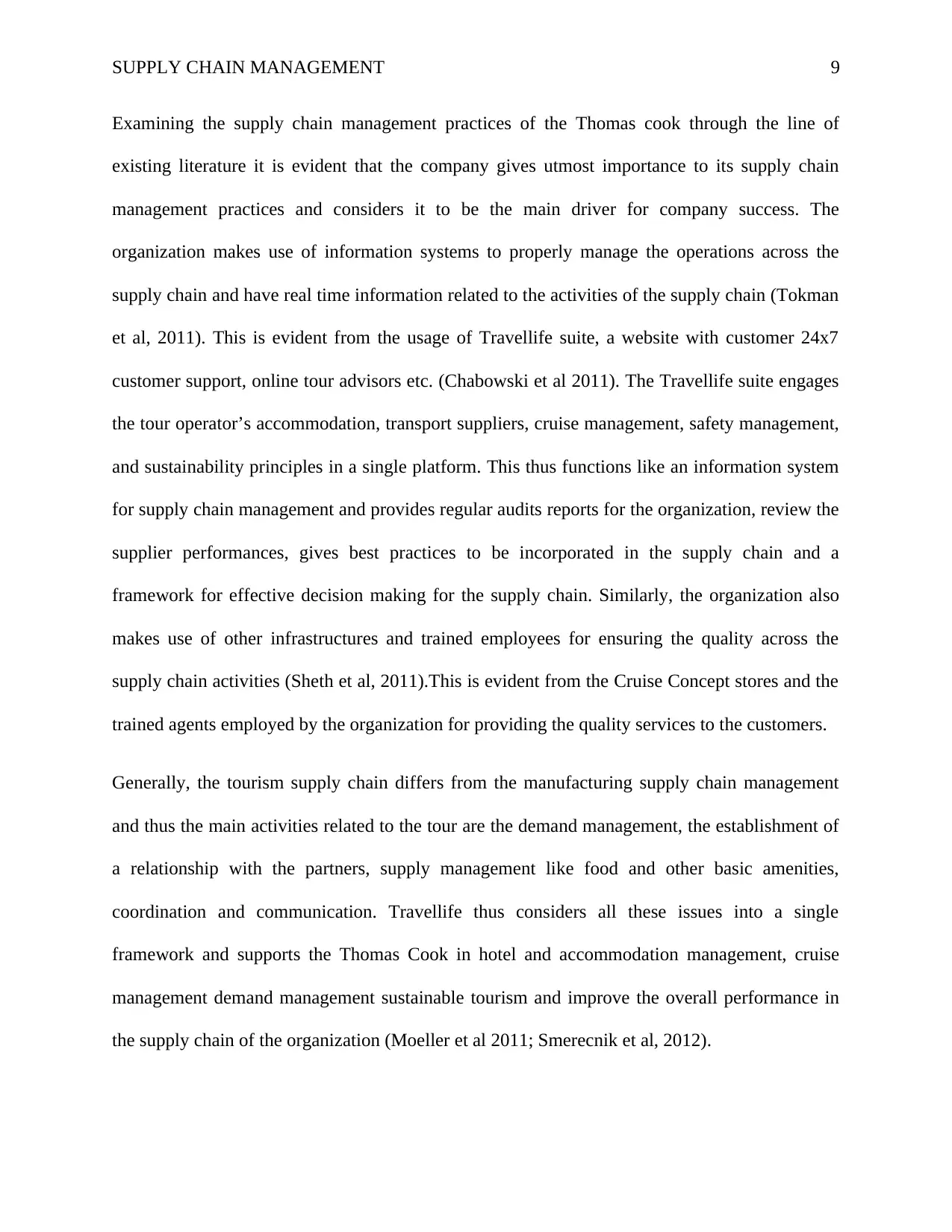
SUPPLY CHAIN MANAGEMENT 9
Examining the supply chain management practices of the Thomas cook through the line of
existing literature it is evident that the company gives utmost importance to its supply chain
management practices and considers it to be the main driver for company success. The
organization makes use of information systems to properly manage the operations across the
supply chain and have real time information related to the activities of the supply chain (Tokman
et al, 2011). This is evident from the usage of Travellife suite, a website with customer 24x7
customer support, online tour advisors etc. (Chabowski et al 2011). The Travellife suite engages
the tour operator’s accommodation, transport suppliers, cruise management, safety management,
and sustainability principles in a single platform. This thus functions like an information system
for supply chain management and provides regular audits reports for the organization, review the
supplier performances, gives best practices to be incorporated in the supply chain and a
framework for effective decision making for the supply chain. Similarly, the organization also
makes use of other infrastructures and trained employees for ensuring the quality across the
supply chain activities (Sheth et al, 2011).This is evident from the Cruise Concept stores and the
trained agents employed by the organization for providing the quality services to the customers.
Generally, the tourism supply chain differs from the manufacturing supply chain management
and thus the main activities related to the tour are the demand management, the establishment of
a relationship with the partners, supply management like food and other basic amenities,
coordination and communication. Travellife thus considers all these issues into a single
framework and supports the Thomas Cook in hotel and accommodation management, cruise
management demand management sustainable tourism and improve the overall performance in
the supply chain of the organization (Moeller et al 2011; Smerecnik et al, 2012).
Examining the supply chain management practices of the Thomas cook through the line of
existing literature it is evident that the company gives utmost importance to its supply chain
management practices and considers it to be the main driver for company success. The
organization makes use of information systems to properly manage the operations across the
supply chain and have real time information related to the activities of the supply chain (Tokman
et al, 2011). This is evident from the usage of Travellife suite, a website with customer 24x7
customer support, online tour advisors etc. (Chabowski et al 2011). The Travellife suite engages
the tour operator’s accommodation, transport suppliers, cruise management, safety management,
and sustainability principles in a single platform. This thus functions like an information system
for supply chain management and provides regular audits reports for the organization, review the
supplier performances, gives best practices to be incorporated in the supply chain and a
framework for effective decision making for the supply chain. Similarly, the organization also
makes use of other infrastructures and trained employees for ensuring the quality across the
supply chain activities (Sheth et al, 2011).This is evident from the Cruise Concept stores and the
trained agents employed by the organization for providing the quality services to the customers.
Generally, the tourism supply chain differs from the manufacturing supply chain management
and thus the main activities related to the tour are the demand management, the establishment of
a relationship with the partners, supply management like food and other basic amenities,
coordination and communication. Travellife thus considers all these issues into a single
framework and supports the Thomas Cook in hotel and accommodation management, cruise
management demand management sustainable tourism and improve the overall performance in
the supply chain of the organization (Moeller et al 2011; Smerecnik et al, 2012).
⊘ This is a preview!⊘
Do you want full access?
Subscribe today to unlock all pages.

Trusted by 1+ million students worldwide
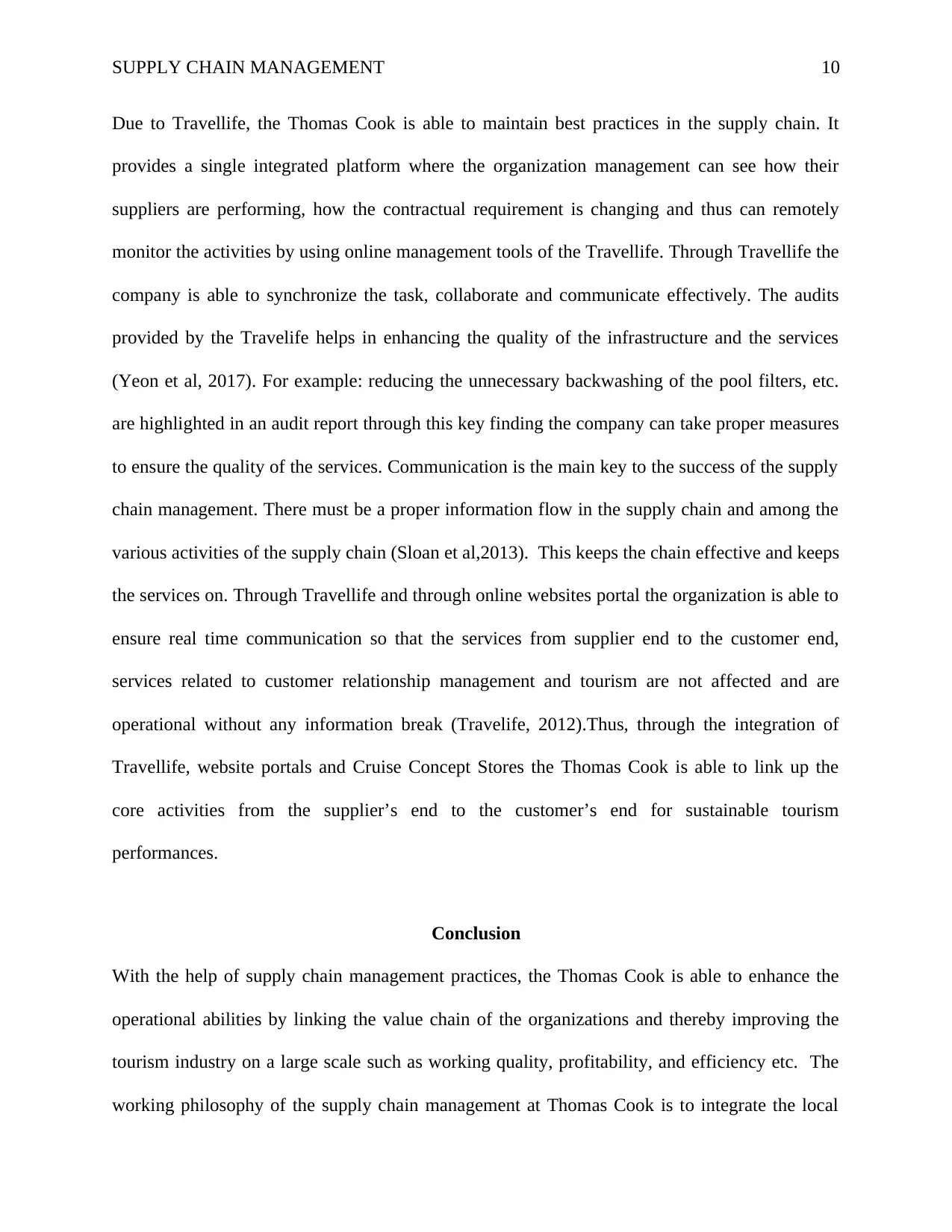
SUPPLY CHAIN MANAGEMENT 10
Due to Travellife, the Thomas Cook is able to maintain best practices in the supply chain. It
provides a single integrated platform where the organization management can see how their
suppliers are performing, how the contractual requirement is changing and thus can remotely
monitor the activities by using online management tools of the Travellife. Through Travellife the
company is able to synchronize the task, collaborate and communicate effectively. The audits
provided by the Travelife helps in enhancing the quality of the infrastructure and the services
(Yeon et al, 2017). For example: reducing the unnecessary backwashing of the pool filters, etc.
are highlighted in an audit report through this key finding the company can take proper measures
to ensure the quality of the services. Communication is the main key to the success of the supply
chain management. There must be a proper information flow in the supply chain and among the
various activities of the supply chain (Sloan et al,2013). This keeps the chain effective and keeps
the services on. Through Travellife and through online websites portal the organization is able to
ensure real time communication so that the services from supplier end to the customer end,
services related to customer relationship management and tourism are not affected and are
operational without any information break (Travelife, 2012).Thus, through the integration of
Travellife, website portals and Cruise Concept Stores the Thomas Cook is able to link up the
core activities from the supplier’s end to the customer’s end for sustainable tourism
performances.
Conclusion
With the help of supply chain management practices, the Thomas Cook is able to enhance the
operational abilities by linking the value chain of the organizations and thereby improving the
tourism industry on a large scale such as working quality, profitability, and efficiency etc. The
working philosophy of the supply chain management at Thomas Cook is to integrate the local
Due to Travellife, the Thomas Cook is able to maintain best practices in the supply chain. It
provides a single integrated platform where the organization management can see how their
suppliers are performing, how the contractual requirement is changing and thus can remotely
monitor the activities by using online management tools of the Travellife. Through Travellife the
company is able to synchronize the task, collaborate and communicate effectively. The audits
provided by the Travelife helps in enhancing the quality of the infrastructure and the services
(Yeon et al, 2017). For example: reducing the unnecessary backwashing of the pool filters, etc.
are highlighted in an audit report through this key finding the company can take proper measures
to ensure the quality of the services. Communication is the main key to the success of the supply
chain management. There must be a proper information flow in the supply chain and among the
various activities of the supply chain (Sloan et al,2013). This keeps the chain effective and keeps
the services on. Through Travellife and through online websites portal the organization is able to
ensure real time communication so that the services from supplier end to the customer end,
services related to customer relationship management and tourism are not affected and are
operational without any information break (Travelife, 2012).Thus, through the integration of
Travellife, website portals and Cruise Concept Stores the Thomas Cook is able to link up the
core activities from the supplier’s end to the customer’s end for sustainable tourism
performances.
Conclusion
With the help of supply chain management practices, the Thomas Cook is able to enhance the
operational abilities by linking the value chain of the organizations and thereby improving the
tourism industry on a large scale such as working quality, profitability, and efficiency etc. The
working philosophy of the supply chain management at Thomas Cook is to integrate the local
Paraphrase This Document
Need a fresh take? Get an instant paraphrase of this document with our AI Paraphraser
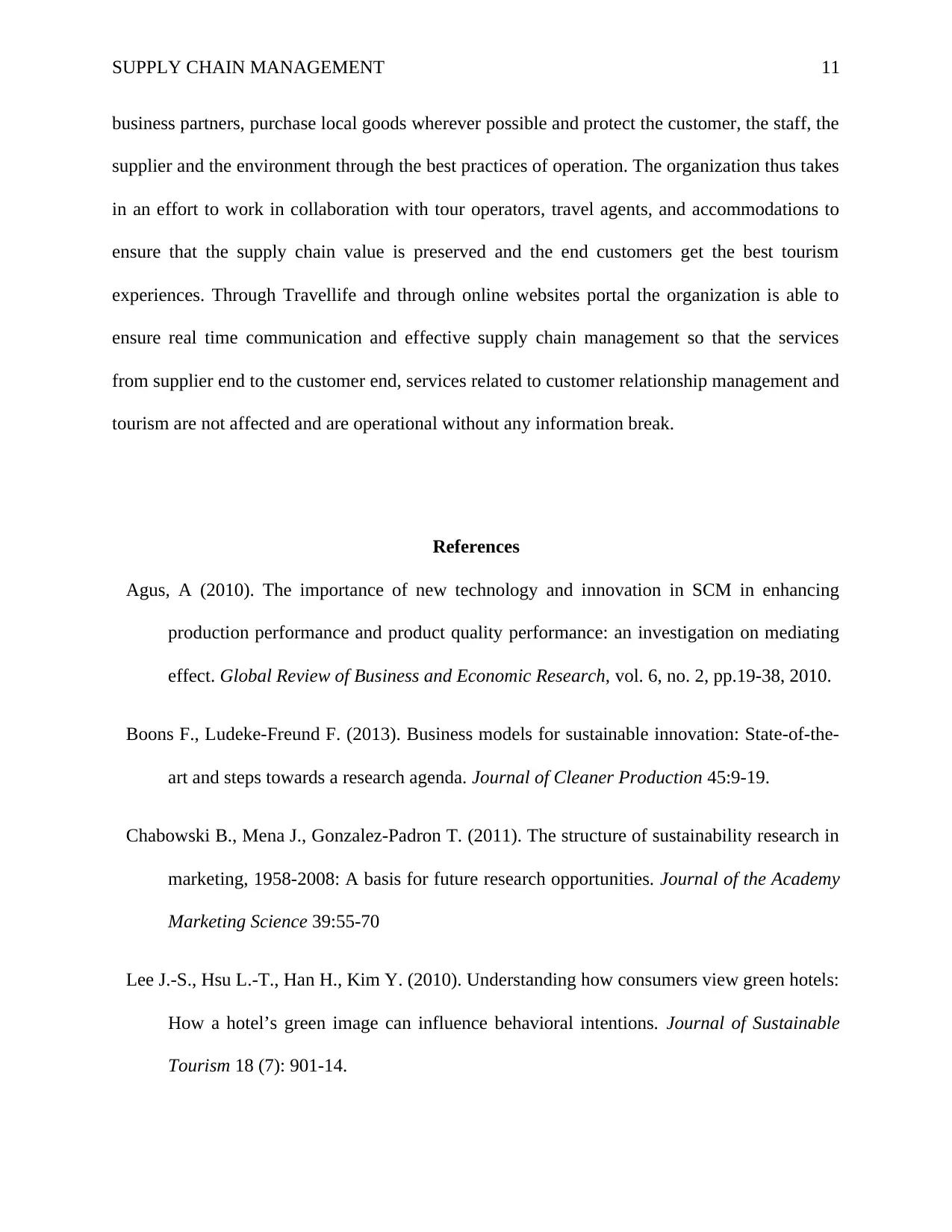
SUPPLY CHAIN MANAGEMENT 11
business partners, purchase local goods wherever possible and protect the customer, the staff, the
supplier and the environment through the best practices of operation. The organization thus takes
in an effort to work in collaboration with tour operators, travel agents, and accommodations to
ensure that the supply chain value is preserved and the end customers get the best tourism
experiences. Through Travellife and through online websites portal the organization is able to
ensure real time communication and effective supply chain management so that the services
from supplier end to the customer end, services related to customer relationship management and
tourism are not affected and are operational without any information break.
References
Agus, A (2010). The importance of new technology and innovation in SCM in enhancing
production performance and product quality performance: an investigation on mediating
effect. Global Review of Business and Economic Research, vol. 6, no. 2, pp.19-38, 2010.
Boons F., Ludeke-Freund F. (2013). Business models for sustainable innovation: State-of-the-
art and steps towards a research agenda. Journal of Cleaner Production 45:9-19.
Chabowski B., Mena J., Gonzalez-Padron T. (2011). The structure of sustainability research in
marketing, 1958-2008: A basis for future research opportunities. Journal of the Academy
Marketing Science 39:55-70
Lee J.-S., Hsu L.-T., Han H., Kim Y. (2010). Understanding how consumers view green hotels:
How a hotel’s green image can influence behavioral intentions. Journal of Sustainable
Tourism 18 (7): 901-14.
business partners, purchase local goods wherever possible and protect the customer, the staff, the
supplier and the environment through the best practices of operation. The organization thus takes
in an effort to work in collaboration with tour operators, travel agents, and accommodations to
ensure that the supply chain value is preserved and the end customers get the best tourism
experiences. Through Travellife and through online websites portal the organization is able to
ensure real time communication and effective supply chain management so that the services
from supplier end to the customer end, services related to customer relationship management and
tourism are not affected and are operational without any information break.
References
Agus, A (2010). The importance of new technology and innovation in SCM in enhancing
production performance and product quality performance: an investigation on mediating
effect. Global Review of Business and Economic Research, vol. 6, no. 2, pp.19-38, 2010.
Boons F., Ludeke-Freund F. (2013). Business models for sustainable innovation: State-of-the-
art and steps towards a research agenda. Journal of Cleaner Production 45:9-19.
Chabowski B., Mena J., Gonzalez-Padron T. (2011). The structure of sustainability research in
marketing, 1958-2008: A basis for future research opportunities. Journal of the Academy
Marketing Science 39:55-70
Lee J.-S., Hsu L.-T., Han H., Kim Y. (2010). Understanding how consumers view green hotels:
How a hotel’s green image can influence behavioral intentions. Journal of Sustainable
Tourism 18 (7): 901-14.
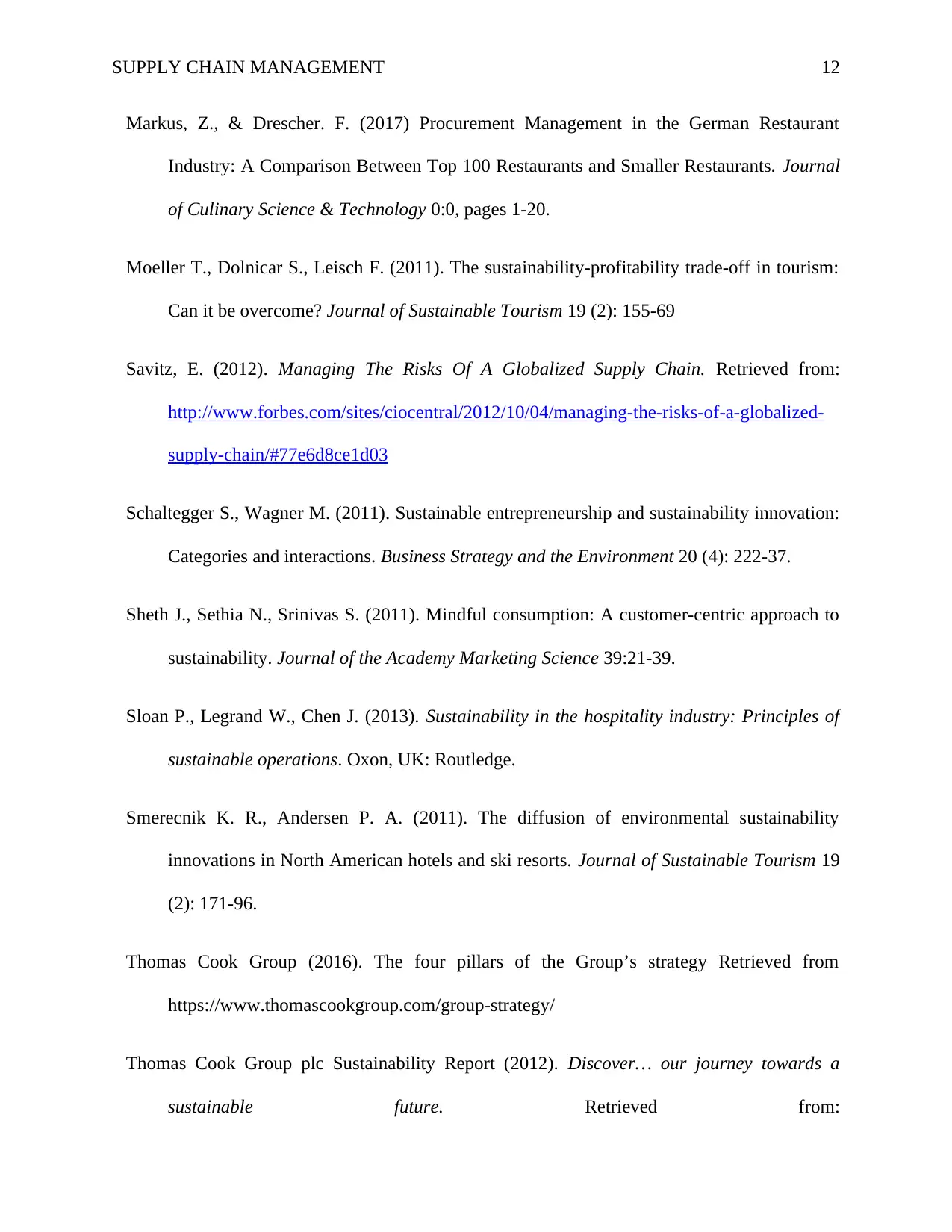
SUPPLY CHAIN MANAGEMENT 12
Markus, Z., & Drescher. F. (2017) Procurement Management in the German Restaurant
Industry: A Comparison Between Top 100 Restaurants and Smaller Restaurants. Journal
of Culinary Science & Technology 0:0, pages 1-20.
Moeller T., Dolnicar S., Leisch F. (2011). The sustainability-profitability trade-off in tourism:
Can it be overcome? Journal of Sustainable Tourism 19 (2): 155-69
Savitz, E. (2012). Managing The Risks Of A Globalized Supply Chain. Retrieved from:
http://www.forbes.com/sites/ciocentral/2012/10/04/managing-the-risks-of-a-globalized-
supply-chain/#77e6d8ce1d03
Schaltegger S., Wagner M. (2011). Sustainable entrepreneurship and sustainability innovation:
Categories and interactions. Business Strategy and the Environment 20 (4): 222-37.
Sheth J., Sethia N., Srinivas S. (2011). Mindful consumption: A customer-centric approach to
sustainability. Journal of the Academy Marketing Science 39:21-39.
Sloan P., Legrand W., Chen J. (2013). Sustainability in the hospitality industry: Principles of
sustainable operations. Oxon, UK: Routledge.
Smerecnik K. R., Andersen P. A. (2011). The diffusion of environmental sustainability
innovations in North American hotels and ski resorts. Journal of Sustainable Tourism 19
(2): 171-96.
Thomas Cook Group (2016). The four pillars of the Group’s strategy Retrieved from
https://www.thomascookgroup.com/group-strategy/
Thomas Cook Group plc Sustainability Report (2012). Discover… our journey towards a
sustainable future. Retrieved from:
Markus, Z., & Drescher. F. (2017) Procurement Management in the German Restaurant
Industry: A Comparison Between Top 100 Restaurants and Smaller Restaurants. Journal
of Culinary Science & Technology 0:0, pages 1-20.
Moeller T., Dolnicar S., Leisch F. (2011). The sustainability-profitability trade-off in tourism:
Can it be overcome? Journal of Sustainable Tourism 19 (2): 155-69
Savitz, E. (2012). Managing The Risks Of A Globalized Supply Chain. Retrieved from:
http://www.forbes.com/sites/ciocentral/2012/10/04/managing-the-risks-of-a-globalized-
supply-chain/#77e6d8ce1d03
Schaltegger S., Wagner M. (2011). Sustainable entrepreneurship and sustainability innovation:
Categories and interactions. Business Strategy and the Environment 20 (4): 222-37.
Sheth J., Sethia N., Srinivas S. (2011). Mindful consumption: A customer-centric approach to
sustainability. Journal of the Academy Marketing Science 39:21-39.
Sloan P., Legrand W., Chen J. (2013). Sustainability in the hospitality industry: Principles of
sustainable operations. Oxon, UK: Routledge.
Smerecnik K. R., Andersen P. A. (2011). The diffusion of environmental sustainability
innovations in North American hotels and ski resorts. Journal of Sustainable Tourism 19
(2): 171-96.
Thomas Cook Group (2016). The four pillars of the Group’s strategy Retrieved from
https://www.thomascookgroup.com/group-strategy/
Thomas Cook Group plc Sustainability Report (2012). Discover… our journey towards a
sustainable future. Retrieved from:
⊘ This is a preview!⊘
Do you want full access?
Subscribe today to unlock all pages.

Trusted by 1+ million students worldwide
1 out of 13
Related Documents
Your All-in-One AI-Powered Toolkit for Academic Success.
+13062052269
info@desklib.com
Available 24*7 on WhatsApp / Email
![[object Object]](/_next/static/media/star-bottom.7253800d.svg)
Unlock your academic potential
Copyright © 2020–2025 A2Z Services. All Rights Reserved. Developed and managed by ZUCOL.





